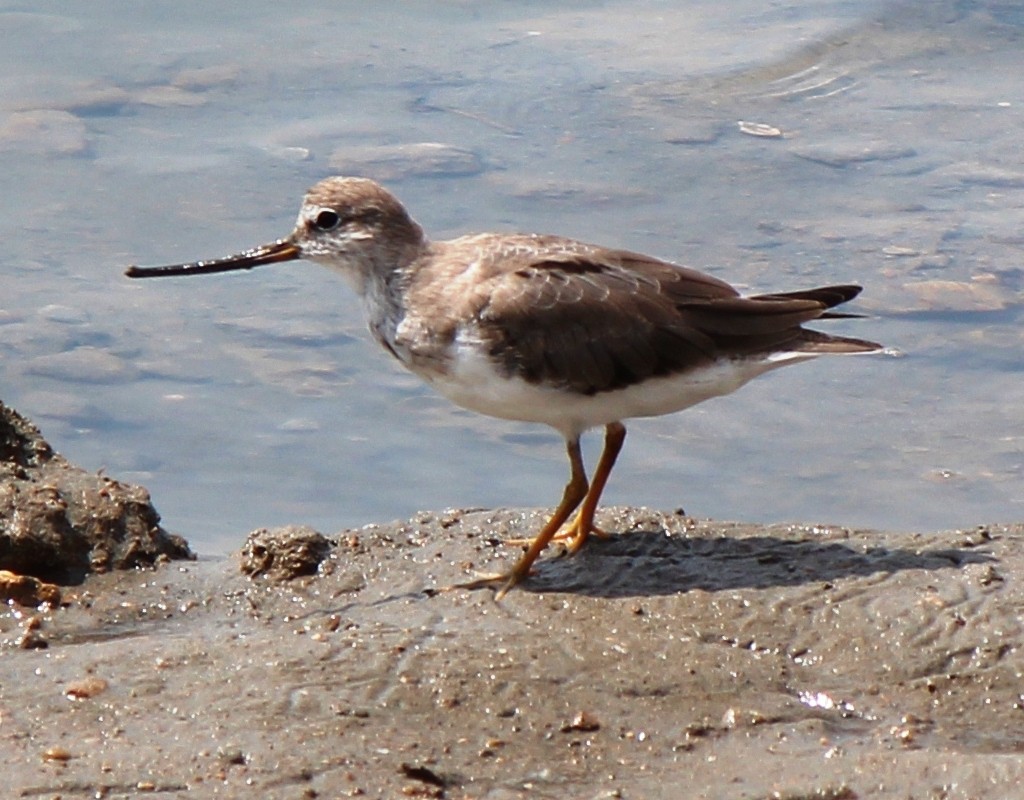Terek Sandpiper
A species of Terek Sandpipers Scientific name : Xenus cinereus Genus : Terek Sandpipers
Terek Sandpiper, A species of Terek Sandpipers
Botanical name: Xenus cinereus
Genus: Terek Sandpipers
Content
Description General Info
 Photo By Alpsdake , used under CC-BY-SA-3.0 /Cropped and compressed from original
Photo By Alpsdake , used under CC-BY-SA-3.0 /Cropped and compressed from original Description
Slightly larger than the common sandpiper at 22–25 cm (8.7–9.8 in) length, its long upcurved bill – somewhat reminiscent of an avocet's, but not as strongly curved – makes it very distinctive. As the scientific specific name implies, this wader has a grey back, face and breast in all plumages; a white supercilium may appear more or less distinct. The belly is whitish and the feet yellow; the bill has a yellowish base, with the rest being black. The call is a high whistle. Among the Scolopacidae, Xenus is part of the shank-tattler-phalarope clade and less closely related to the calidrid sandpipers. Based on the degree of DNA sequence divergence and putative shank and phalarope fossils from around the Oligocene/Miocene boundary some 23–22 million years ago, the Terek sandpiper presumably diverged from their relatives in the Late Oligocene. Given the numerous basal fossils of the group found in Eurasia it is likely that the Terek sandpiper lineage originated there, possibly by being isolated as the remains of the Turgai Sea dried up, which happened just around this time. 
Size
23-28 cm (9-11 in)
Life Expectancy
16 years
Nest Placement
Tree
Feeding Habits
Terek Sandpiper feeds on a variety of prey, including adult and larval midges, seeds, insects, small molluscs, crustaceans, crabs, spiders, and annelid worms. They exhibit specialized foraging techniques, often moving quickly to capture food on mudflats during low tide.
Habitat
The terek Sandpiper resides in varied habitats, from northern taiga and forest tundra regions during breeding to tropical coasts in the non-breeding season. Its environment includes lowland valleys, floodplains with tall grasses, open intertidal mudflats, estuaries, coral reefs, and sandy beaches. It also finds refuge in coastal swamps, saltpans, mangroves, and occasionally inland freshwater wetlands during migration.
Dite type
Herbivorous
General Info
Feeding Habits
Bird food type
Distribution Area
This bird breeds near water in the taiga from Finland through northern Siberia to the Kolyma River, and migrate south in winter to tropical coasts in east Africa, south Asia and Australia, usually preferring muddy areas. It is a rare vagrant in western Europe, and particularly in autumn it is sometimes seen passing through the Marianas on migration; on Palau, further off its usual migration route, it is decidedly uncommon on the other hand. Almost annually and apparently more and more often in recent times, a few birds stray to Alaska and the Aleutian and Pribilof Islands. Every few years, individual vagrants are recorded in the Neotropics, where they arrive either as migrating birds from Africa, or as North American strays accompanying local waders south for winter. Such vagrants have been recorded as far south as Argentina. The overall genetic variation in Terek sandpipers across their range is low, with some evidence of contractions followed by expansion. Although the geographically isolated Dniephe River population in Eastern Europe does show significant genetic differentiation. It feeds in a distinctive and very active way, chasing insects and other mobile prey, and sometimes then running to the water's edge to wash its catch. It lays three or four eggs in a lined ground scrape. The Terek sandpiper likes to associate with ruddy turnstones (Arenaria interpres), smallish calidrids, and Charadrius (but maybe not Pluvialis) plovers; a vagrant bird at Paraty (Rio de Janeiro state) was noted to pair up with a spotted sandpiper (Actitis macularius). Thus it may be that the Terek sandpiper under natural conditions may mate with common sandpiper (A. hypoleucos), the Old World sister species of spotted sandpiper (A. macularius). As hybridisation in shorebirds is extremely commonplace and Actitis is among the closer relatives of the Terek sandpiper, such pairings (should they indeed occur) may produce hybrid offspring. This is one of the species to which the Agreement on the Conservation of African-Eurasian Migratory Waterbirds (AEWA) applies. Widespread and often quite commonly seen, the Terek sandpiper is not considered a threatened species by the IUCN. 
Species Status
Not globally threatened.
Scientific Classification
Phylum
Chordates Class
Birds Order
Shorebirds Family
Sandpipers Genus
Terek Sandpipers Species
Terek Sandpiper